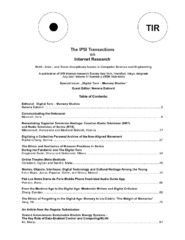Приказ основних података о документу
Communicating the Holocaust
| dc.contributor | Daković, Nevena | |
| dc.creator | Mevorah, Vera | |
| dc.date.accessioned | 2021-10-21T12:02:07Z | |
| dc.date.available | 2021-10-21T12:02:07Z | |
| dc.date.issued | 2021 | |
| dc.identifier.issn | 1820-4503 | |
| dc.identifier.uri | http://rifdt.instifdt.bg.ac.rs/123456789/2290 | |
| dc.description.abstract | This paper deals with role of digital culture and ICT in rethinking Holocaust remembrance, arguing for a semantic, or rather a theoretical change in analyzing Holocaust memory practices - from re-presenting the Holocaust to communicating the Holocaust. We will explore how this framework can provide a new tool for better encompassing and understanding of wide range of memory and representation practices we equate the Holocaust with, from traumatic Holocaust survivor testimonies, historical, cultural and national memory politics, education practices, Jewish Churban, to numerous memorial and artistic production about the Holocaust, but also add to the debates around issues of (non) representability of the Shoah, ethical imperatives of Holocaust memory and post-Holocaust thought. Our goal is to analyze how much this new platform is dependent on the digital turn, that is, how much of this change in perception of Holocaust memory can we find in the cultural paradigm change that came with ICT and digital technology. This digital turn in Holocaust memory is perceived in the increase of the amount of information about the Holocaust, social networks and social media culture dominated landscape, significance of digital archives, networking and collaborative projects, image, video and text reproduction and appropriation, focus on interactivity and communication in education and memorial institutions. We will showcase how big historical and institutional narratives about the Holocaust gave way to the exchange of multitude of stories, opinions and perspectives. How museum, memorial and school settings became entwined with online platforms and their digital materials, and also in what way are those digital materials used, reproduced and changed. Further, we will discuss how the third and fourth post-Holocaust generation are connected to this digital turn in Holocaust memory and whether in their memory and representational practices we can also find the communication turn. | sr |
| dc.language.iso | en | sr |
| dc.publisher | Belgrade: IPSI | sr |
| dc.relation | info:eu-repo/grantAgreement/MESTD/inst-2020/200025/RS// | sr |
| dc.rights | openAccess | sr |
| dc.rights.uri | https://creativecommons.org/licenses/by-nc-nd/4.0/ | |
| dc.source | IPSI Bgd Transactions on Internet Research, Special Issue "Digital Turn – Memory Studies" | sr |
| dc.subject | Holocaust | sr |
| dc.subject | memory | sr |
| dc.subject | digital culture | sr |
| dc.subject | communication | sr |
| dc.subject | representation | sr |
| dc.title | Communicating the Holocaust | sr |
| dc.type | article | sr |
| dc.rights.license | BY-NC-ND | sr |
| dcterms.abstract | Меворах, Вера; | |
| dc.citation.issue | 2 | |
| dc.citation.volume | 17 | |
| dc.citation.spage | 8 | |
| dc.citation.epage | 16 | |
| dc.type.version | publishedVersion | sr |
| dc.identifier.fulltext | http://rifdt.instifdt.bg.ac.rs/bitstream/id/8174/bitstream_8174.pdf | |
| dc.identifier.rcub | https://hdl.handle.net/21.15107/rcub_rifdt_2290 |

